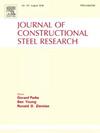不同应变比下EQ56船用高强度钢的多轴疲劳行为
IF 4
2区 工程技术
Q1 CONSTRUCTION & BUILDING TECHNOLOGY
引用次数: 0
摘要
对海洋平台用EQ56高强度钢进行了多轴低周疲劳试验,研究了多轴应变比(λ = 3/ 2,3, 1.53, 23)和应变幅值(∆ε/2 =±0.29%,±0.35%,±0.42%,±0.57%,±0.75%)对循环行为的影响。在高应变比和高应变幅值下,材料表现出明显的循环硬化,而在低应变比和低应变幅值下,材料没有硬化行为。在整个疲劳寿命中,材料主要表现为循环软化。利用三维景深成像技术对断口进行分析,发现随着应变比的增加,断裂模式从拉伸模式向剪切模式转变,表明其为混合破坏模式。扫描电子显微镜(SEM)观察进一步证实了这种转变,通过轮胎样的痕迹和越来越模糊的解理特征,归因于剪切成分的影响。对4种临界平面多轴疲劳寿命预测模型进行了对比分析。考虑混合失效模式的Wu-Hu-Song (WHS)模型预测精度为78%,平均相对误差(MRE)为22.8%。修正后的KBM模型和WHS模型(即KBM- m、WHS- m)考虑了多轴应变比的影响,其预测精度提高,预测离散度降低,MRE值分别为12.6%和15%。本文章由计算机程序翻译,如有差异,请以英文原文为准。
Multiaxial fatigue behavior of EQ56 marine high-strength steel under different strain ratios
Multiaxial low-cycle fatigue tests were conducted on EQ56 high-strength steel for offshore platforms, investigating the effects of multiaxial strain ratios (λ = , , , ) and strain amplitudes (∆ε/2 = ±0.29 %, ±0.35 %, ±0.42 %, ±0.57 %, ±0.75 %) on cyclic behavior. The material exhibits pronounced cyclic hardening at high strain ratios and amplitudes, while at low strain ratios and amplitudes, the hardening behavior is not observed. Throughout the fatigue life, the material predominantly exhibits cyclic softening. Fractographic analysis using 3D depth-of-field imaging reveals a transition from tensile to shear failure modes with increasing strain ratio, indicating a mixed failure mode. Scanning electron microscopy (SEM) observations further confirm this transition through tire-like traces and increasingly blurred cleavage features, attributed to the influence of shear components. A comparative analysis of four critical plane multiaxial fatigue life prediction models was conducted. The Wu-Hu-Song (WHS) model, which accounts for mixed failure modes, achieved 78 % prediction accuracy with a mean relative error (MRE) of 22.8 %. The modified Kandil-Brown-Miller (KBM) model and WHS model (i.e., KBM-M, WHS-M), which incorporate the effect of multiaxial strain ratios and show improved accuracy and reduced prediction dispersion, with MRE values of 12.6 % and 15 %, respectively.
求助全文
通过发布文献求助,成功后即可免费获取论文全文。
去求助
来源期刊

Journal of Constructional Steel Research
工程技术-工程:土木
CiteScore
7.90
自引率
19.50%
发文量
550
审稿时长
46 days
期刊介绍:
The Journal of Constructional Steel Research provides an international forum for the presentation and discussion of the latest developments in structural steel research and their applications. It is aimed not only at researchers but also at those likely to be most affected by research results, i.e. designers and fabricators. Original papers of a high standard dealing with all aspects of steel research including theoretical and experimental research on elements, assemblages, connection and material properties are considered for publication.
 求助内容:
求助内容: 应助结果提醒方式:
应助结果提醒方式:


